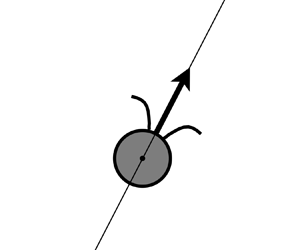Published online by Cambridge University Press: 13 October 2023

We calculate the hydrodynamic force on a small spherical, unsteady squirmer moving with a time-dependent velocity in a fluid at rest, taking into account convective and unsteady fluid inertia effects in perturbation theory. Our results generalise those of Lovalenti & Brady (J. Fluid Mech., vol. 256, 1993, pp. 561–605) from passive to active spherical particles. We find that convective inertia changes the history contribution to the hydrodynamic force, as it does for passive particles. We determine how the hydrodynamic force depends on the swimming gait of the unsteady squirmer. Since swimming breaks the spherical symmetry of the problem, the force is not determined completely by the outer solution of the asymptotic matching problem, as it is for passive spheres. There are additional contributions due to the inhomogeneous solution of the inner problem. We also compute the disturbance flow, illustrating convective and unsteady effects when the particle experiences a sudden start followed by a sudden stop.